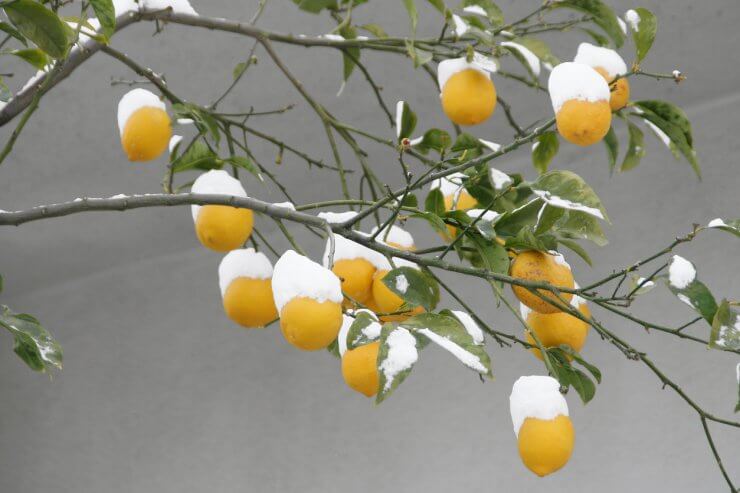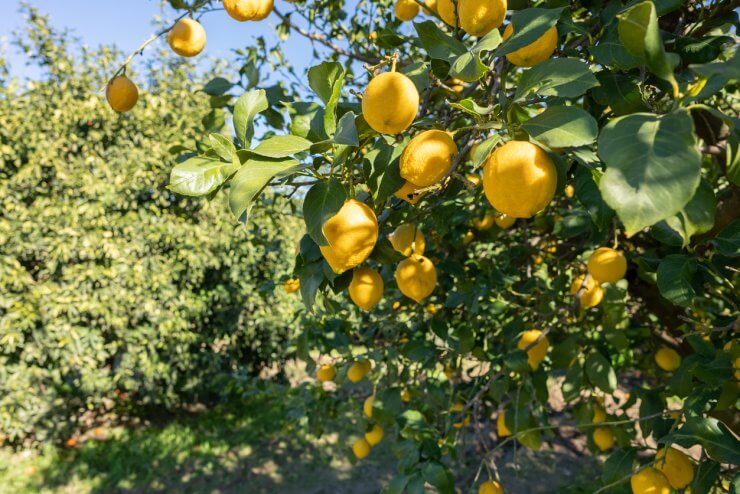
Lemon tree with snow
Let’s break this down month by month, with real talk about how your location completely changes the game plan.
First: Know Your Zone (or Your Tree Will Remind You)
Zones 9–11 (The Citrus Promised Land): Your trees live outside permanently. You’re basically playing gardening on easy mode, and I’m only slightly jealous.
Zones 7–8 (The Negotiators): Container growing is your friend. You’ll be schlepping your tree indoors for winter like you’re moving a reluctant, thorny roommate who weighs 50 pounds.
Zone 6 and below: I mean, technically you could grow a lemon tree, but it’s going to be a container situation with more helicopter parenting than a kid at a spelling bee.

WINTER: December – February
For the Warm Zone Warriors (9–11):
Your lemon tree is outside, possibly still blooming like it hasn’t read the calendar. Here’s your cheat sheet:
Water: Cut back to once every 7–10 days. Even in Florida, growth slows when daylight decreases. Fun fact: it’s not temperature that triggers dormancy in citrus – it’s photoperiod (day length). Your tree is literally counting sunlight hours like a botanical accountant.
Feeding: Stop fertilizing. Your tree is in cruise control, and feeding it now creates soft, cold-sensitive growth. That’s like sending your kid to play in snow wearing shorts – technically possible, but why?
Pest watch: Scale insects are winter squatters. Check branch undersides and remove with rubbing alcohol on a cotton swab. Yes, you’re giving your tree a medical exam. No, it doesn’t appreciate your effort.
For the Container Haulers (7–8 and below):
THE BIG MOVE: When nighttime temps consistently hit 40°F (4°C), it’s go-time. Moving your tree indoors isn’t optional unless you’re interested in expensive outdoor modern art titled “Dead Stick.”
Here’s what nobody tells you: Bring it in BEFORE you turn on your heat. The transition from 60°F outside to 72°F inside is manageable. The jump from 35°F to 72°F with zero humidity? That’s tree shock equivalent to teleporting from Alaska to the Sahara.
The Indoor Reality Check:
- Place near your brightest south-facing window
- Expect leaf drop. Like, a LOT of leaf drop. This is normal grieving behavior.
- Water sparingly – maybe once every 10–14 days. Overwatering dormant indoor citrus is the #1 cause of “why did my tree turn into a sad stick?”
- Get a grow light if your house has the natural lighting of a cave. Your tree needs 8+ hours of bright light or it’ll stage a protest.
Pro move: Set your tree on a pebble tray with water (not touching the pot bottom). Indoor heating = Sahara Desert humidity levels. The evaporating water creates a microclimate. It’s like a humidifier, but more passive-aggressive.

SPRING: March – May
Warm Zones:
March: FERTILIZER TIME! Start feeding every 4–6 weeks with citrus-specific fertilizer. Here’s your nerd moment: citrus need extra iron, zinc, and manganese because they’re genetically predisposed to deficiencies. It’s like how some people can’t process gluten – citrus are just botanically high-maintenance.
April: Prime pruning window. Cut out dead wood, crossing branches, and anything growing below the graft union (those are imposters trying to turn your Meyer lemon into a sour rootstock lemon – it’s botanical identity theft).
May: Increase watering to 2–3 times weekly. Your tree is now speed-growing like a teenager who ate all the groceries.
Container Crew:
THE GREAT OUTDOORS RETURN: When nighttime temps stabilize above 50°F (10°C), you can transition your tree back outside. But here’s the catch – you can’t just yeet it into full sun after months in your living room. That’s like taking a gamer outside at noon. Sunburn city.
Hardening off schedule (yes, really):
- Week 1: Outside in shade for 2–3 hours daily
- Week 2: Partial sun (morning only) for 4–5 hours
- Week 3: Increase sun exposure gradually
- Week 4: Full sun achieved. Your tree is now acclimated and ready to photosynthesize like a champion.
April-May for EVERYONE: Start fertilizing. Prune. Check for overwintering pests (those sneaky jerks). And if you see flowers – CELEBRATE! Each flower is a potential lemon, and lemon trees can self-pollinate, but a gentle shake or fan helps. Be the bee your tree needs.

SUMMER: June – August
This is when climate zones matter less because EVERYONE’S tree is in beast mode.
Watering for all: 2–3 times weekly, deep soaking until water runs from drainage holes. The “finger test” is your friend – stick your finger 2–3 inches into soil. Dry? Water. Damp? Wait. Soggy? You’ve got a problem, friend.
The mulch situation: Apply 3–4 inches of organic mulch (wood chips, bark, aged compost) around but NOT touching the trunk. This:
- Keeps roots cool (citrus roots are wimps in 90°F+ soil)
- Retains moisture (less watering = less work)
- Slowly feeds your tree as it decomposes (it’s like a slow-release vitamin)
Science tangent you didn’t ask for: Lemon trees can handle up to about 100°F before they start stress-dropping fruit and leaves. Above that, they’re basically melting. If you’re in Arizona or inland California and it’s 115°F, shade cloth (30–50% reduction) is your friend.
Fertilizing: Keep at it every 4–6 weeks. Your tree is a nutrient-hungry machine right now.
Pest apocalypse watch: Aphids, scale, spider mites, and leaf miners all LOVE summer citrus. My defense strategy: spray with hose first (just blast them off like you’re power washing). If that fails, neem oil or insecticidal soap. If THAT fails, order lemons from the store and question your life choices.

FALL: September – November
Warm Zones:
September-October: Often a second bloom period! Yes, your tree can flower AND hold ripe fruit simultaneously because it’s an overachiever with no sense of work-life balance.
Harvest wisdom: Lemons are ripe when fully colored with slight give. But here’s the insider secret – they can hang on the tree for MONTHS post-ripening, actually getting sweeter and juicier. They’re nature’s refrigerator. Don’t rush them unless you need them.
November: Reduce fertilizing as days shorten. Your tree is reading day length signals and starting to chill out. Feeding now = soft growth that’s frost-vulnerable.
Container Folk:
September-October: Same as warm zones, but start mentally preparing for The Return of Indoor Tree Life.
November: When temps start flirting with 40°F at night, start your transition plan. Begin moving the tree into a protected area (garage, covered porch) during cold nights. This is like training camp for full indoor living.
Final fertilizer: Last feeding should be 4–6 weeks before you bring it inside permanently. You want it going dormant, not trying to grow in your living room with the enthusiasm of an unsupervised toddler.
The Universal Truth Nobody Mentions
Inconsistent watering causes more lemon tree drama than anything else. It leads to:
- Fruit splitting (looks like horror movie lemons)
- Leaf drop (tree tantrum behavior)
- Blossom drop (reproductive strike)
- Root rot (death by kindness)
The solution? Water on a SCHEDULE based on your climate, season, and soil check. Not when you remember. Not when you feel guilty. Actual scheduled care.
Your Lemon Tree Personality Match
Are you Zone 9–11? Congratulations, you won the citrus lottery. Your main job is not screwing up something that basically wants to succeed.
Are you Zone 7–8? You’re a container citrus parent. Embrace the seasonal shuffle. Buy a plant dolly. Accept that your tree will give you side-eye every November.
Are you Zone 6 and below? You’re hardcore. You’re committed. You’re possibly slightly unhinged about citrus, and honestly? I respect that energy.
Now go forth and adjust your care based on where you actually live, not where that garden blogger in Santa Barbara lives. Your lemon tree will thank you with actual lemons instead of passive-aggressive leaf dropping. Want to learn more about growing lemons? Check out our Lemon Growing Guide today!


 Previous
Previous

